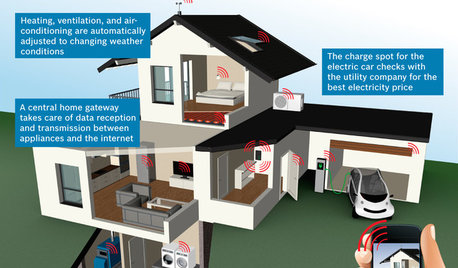motion sensor to actuate fan, relay needed?
gratefulgary
13 years ago
Related Stories

MOVING10 Rooms That Show You Don’t Need to Move to Get More Space
Daydreaming about moving or expanding but not sure if it’s practical right now? Consider these alternatives
Full Story
BATHROOM DESIGN6 Elements of a Perfect Bathroom Paint Job
High-quality paint alone won't cut it. For the best-looking painted bathroom walls, you'll need to get these other details right
Full Story
BATHROOM DESIGN9 Big Space-Saving Ideas for Tiny Bathrooms
Look to these layouts and features to fit everything you need in the bath without feeling crammed in
Full Story
GARAGESKey Measurements for the Perfect Garage
Get the dimensions that will let you fit one or more cars in your garage, plus storage and other needs
Full Story
KITCHEN SINKSJust a Touch: Faucets Without the Fuss
Faucets that turn on with a tap of the finger, forearm or hand are great for messy hands or full arms
Full Story
GREEN BUILDINGMy Houzz: Sustainability Meets Global Style on an Australian Hilltop
It puts the power of the sun to work while keeping the budget in check and family socializing front and center
Full Story
THE HARDWORKING HOMECES 2015: Inching Toward a Smarter Home
Companies are betting big on connected devices in 2015. Here’s a look at what’s to come
Full Story
LIGHTINGWhat to Know About Switching to LED Lightbulbs
If you’ve been thinking about changing over to LEDs but aren't sure how to do it and which to buy, this story is for you
Full Story
HOME TECHOn the Internet, Nobody Knows You're a Lamp
Home appliances and devices are poised to get on the Internet and start messaging one another. Here's why that'll be great for you
Full Story
BATHROOM DESIGNWindows That Expose Your Bathroom to Light Without Exposing You
Enjoy the best of both worlds with window tricks that give you privacy along with the views and natural light
Full Story








brickeyee
pharkus
Related Professionals
Endicott General Contractors · Nampa General Contractors · Roseburg General Contractors · Phoenix Solar Energy Systems · East Lake Solar Energy Systems · Maple Grove Solar Energy Systems · Rehoboth Solar Energy Systems · Waltham Solar Energy Systems · Wasco Solar Energy Systems · Brookfield Home Automation & Home Media · La Crescenta-Montrose Home Automation & Home Media · Lewisville Home Automation & Home Media · Springville Home Automation & Home Media · Winchester Home Automation & Home Media · Weston Home Automation & Home Mediabrickeyee
gratefulgaryOriginal Author
pharkus
yosemitebill
gratefulgaryOriginal Author
brickeyee
pharkus
windslam
pharkus
brickeyee
windslam
jmorrow
pharkus
alan_s_thefirst
pharkus
alan_s_thefirst